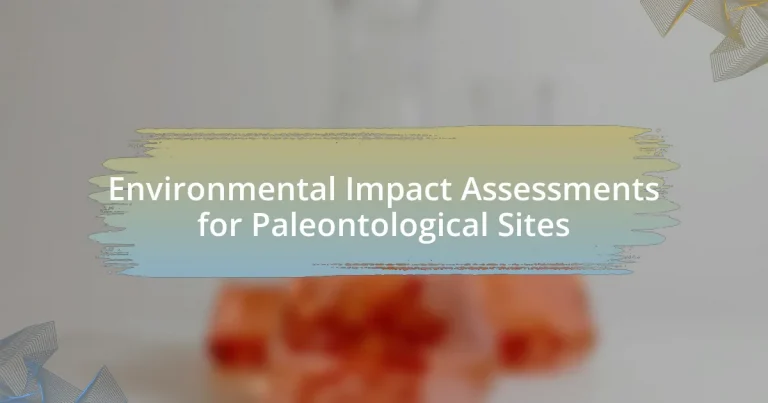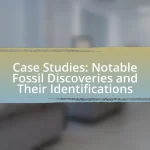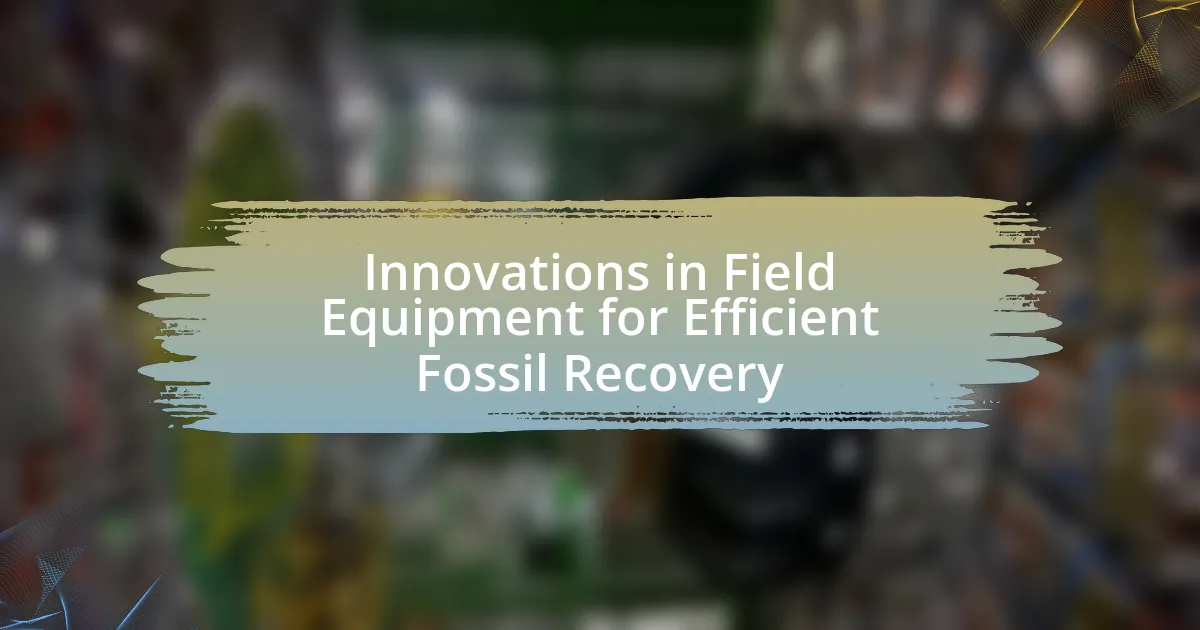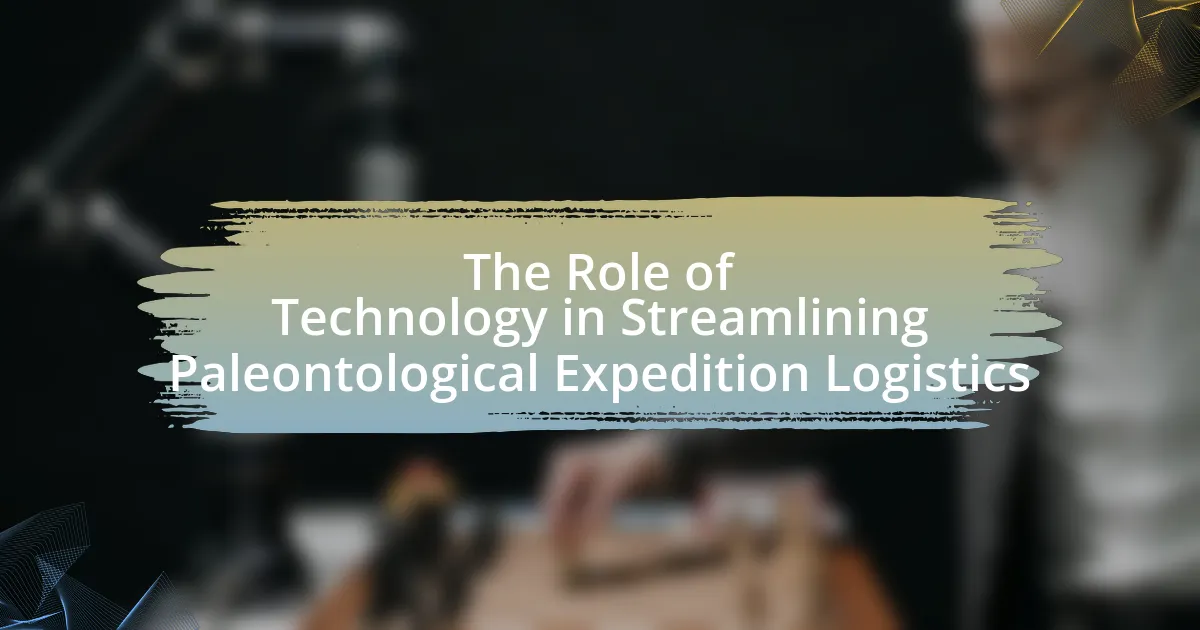Environmental Impact Assessments (EIAs) for paleontological sites are systematic evaluations designed to assess the potential effects of development projects on fossil resources and their geological contexts. These assessments are essential for identifying, predicting, and mitigating impacts on significant paleontological resources, thereby ensuring their preservation and protection. The article outlines the importance of EIAs in maintaining scientific integrity and cultural heritage, discusses the methodologies used in conducting these assessments, and highlights the challenges faced in data collection and analysis. Additionally, it emphasizes the role of regulatory frameworks in shaping assessment processes and the strategies employed to mitigate impacts on paleontological sites, ultimately influencing conservation efforts and policy decisions.
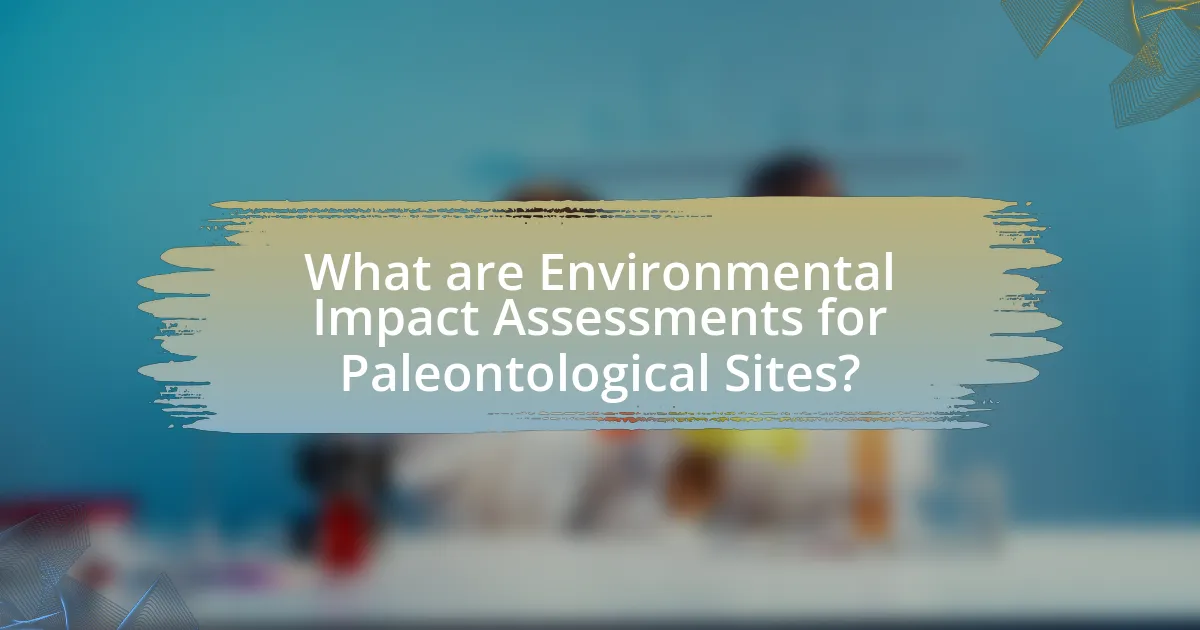
What are Environmental Impact Assessments for Paleontological Sites?
Environmental Impact Assessments (EIAs) for paleontological sites are systematic evaluations that assess the potential effects of proposed projects on fossil resources and their geological context. These assessments aim to identify, predict, and mitigate impacts on paleontological resources, ensuring that significant fossil sites are preserved and protected during development activities. EIAs are often mandated by environmental regulations and involve field surveys, data collection, and consultation with paleontologists to evaluate the importance of the fossil resources at the site.
Why are Environmental Impact Assessments important for paleontological sites?
Environmental Impact Assessments (EIAs) are crucial for paleontological sites because they help identify and mitigate potential adverse effects on fossil resources during development projects. EIAs ensure that significant paleontological resources are documented, preserved, and protected, thereby maintaining scientific integrity and cultural heritage. For instance, the National Environmental Policy Act (NEPA) mandates that federal agencies consider the impacts of their actions on paleontological resources, which has led to the preservation of numerous significant fossil sites across the United States. This legal framework underscores the importance of EIAs in safeguarding paleontological heritage while balancing development needs.
What role do paleontological sites play in understanding Earth’s history?
Paleontological sites are crucial for understanding Earth’s history as they provide direct evidence of past life forms and their environments. These sites contain fossils that reveal information about the evolution of species, climate changes, and geological events over millions of years. For instance, the fossil record from the Burgess Shale in Canada has offered insights into the Cambrian explosion, showcasing the rapid diversification of life approximately 541 million years ago. Such evidence allows scientists to reconstruct ancient ecosystems and understand the biological and environmental factors that shaped the planet’s history.
How do Environmental Impact Assessments protect these sites?
Environmental Impact Assessments (EIAs) protect paleontological sites by systematically evaluating the potential effects of proposed projects on these areas. EIAs require developers to identify, predict, and assess the impacts of their activities on paleontological resources, ensuring that significant sites are preserved. For instance, regulations often mandate that if a site contains fossils or other significant geological features, mitigation measures must be implemented, such as altering project plans or conducting further research. This process is supported by legal frameworks, such as the National Environmental Policy Act in the United States, which emphasizes the importance of considering environmental impacts, including those on paleontological resources, before project approval.
What are the key components of an Environmental Impact Assessment for paleontological sites?
The key components of an Environmental Impact Assessment (EIA) for paleontological sites include baseline studies, impact analysis, mitigation measures, and monitoring plans. Baseline studies involve documenting existing paleontological resources and their significance, which is essential for understanding potential impacts. Impact analysis assesses how proposed activities may affect these resources, considering factors such as excavation or construction. Mitigation measures outline strategies to minimize adverse effects on paleontological sites, such as relocation of fossils or preservation in situ. Finally, monitoring plans ensure ongoing assessment of impacts during and after project implementation, allowing for adaptive management. These components collectively ensure that paleontological resources are adequately protected during development activities.
What methodologies are used in conducting these assessments?
Environmental Impact Assessments for Paleontological Sites utilize methodologies such as field surveys, remote sensing, and geospatial analysis. Field surveys involve systematic examination of the site to identify and document paleontological resources, while remote sensing employs aerial imagery and satellite data to assess land use and geological features. Geospatial analysis integrates geographic information systems (GIS) to evaluate spatial relationships and potential impacts on paleontological resources. These methodologies are validated by their widespread application in environmental assessments, ensuring comprehensive evaluation of potential impacts on fossil sites.
How is data collected and analyzed during the assessment process?
Data is collected and analyzed during the assessment process through systematic field surveys, sampling, and laboratory analyses. Field surveys involve the identification and documentation of paleontological resources, including fossils and geological formations, often utilizing GPS technology for precise location tracking. Sampling techniques, such as stratigraphic sampling, allow researchers to gather representative specimens from various layers of sediment. Laboratory analyses, including radiometric dating and isotopic studies, provide insights into the age and environmental conditions of the fossilized remains. This multi-faceted approach ensures comprehensive data collection, enabling accurate assessments of potential impacts on paleontological sites.
What challenges are faced in conducting Environmental Impact Assessments for paleontological sites?
Conducting Environmental Impact Assessments (EIAs) for paleontological sites faces several challenges, primarily due to the complexity of assessing fossil resources and their significance. One major challenge is the difficulty in accurately identifying and evaluating the paleontological resources present, as many fossils may be buried or not easily visible, leading to underestimation of their importance. Additionally, the lack of standardized methodologies for assessing paleontological impacts complicates the process, as different jurisdictions may have varying requirements and guidelines. Furthermore, the integration of paleontological data with other environmental factors can be challenging, as it requires interdisciplinary collaboration among paleontologists, ecologists, and environmental scientists. These challenges are compounded by time constraints and limited funding, which can hinder thorough assessments and the implementation of mitigation strategies.
What are the common obstacles in data collection and analysis?
Common obstacles in data collection and analysis for Environmental Impact Assessments for Paleontological Sites include limited access to sites, insufficient funding, and lack of standardized methodologies. Limited access often arises due to legal restrictions or environmental conditions that hinder fieldwork. Insufficient funding restricts the scope and scale of data collection efforts, impacting the quality and quantity of data gathered. Additionally, the absence of standardized methodologies can lead to inconsistencies in data collection and analysis, making it difficult to compare results across different studies. These obstacles can significantly affect the reliability and comprehensiveness of assessments in paleontological contexts.
How do regulatory frameworks impact the assessment process?
Regulatory frameworks significantly influence the assessment process by establishing guidelines and standards that must be followed during Environmental Impact Assessments (EIAs) for paleontological sites. These frameworks dictate the methodologies used, the data required, and the stakeholder engagement processes, ensuring that assessments are thorough and compliant with legal requirements. For instance, the National Environmental Policy Act (NEPA) in the United States mandates that federal agencies evaluate the environmental effects of their proposed actions, which includes assessing impacts on paleontological resources. This legal obligation ensures that potential harm to significant fossil sites is considered and mitigated, thereby enhancing the protection of these resources during development projects.
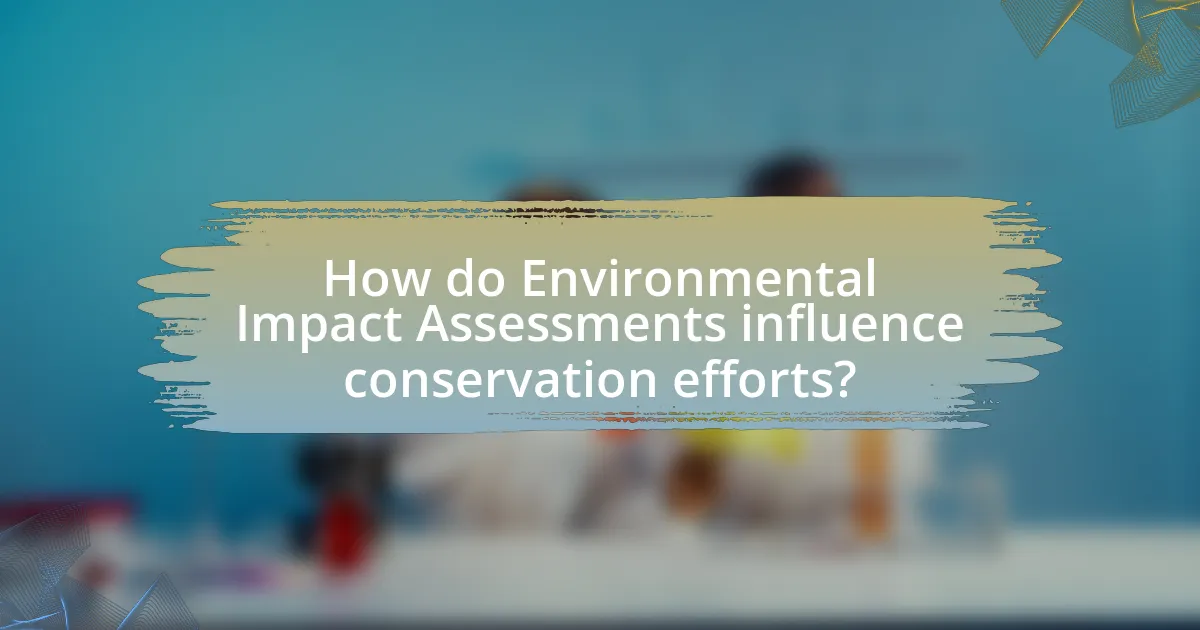
How do Environmental Impact Assessments influence conservation efforts?
Environmental Impact Assessments (EIAs) significantly influence conservation efforts by systematically evaluating the potential environmental effects of proposed projects, thereby informing decision-makers about the ecological implications. EIAs help identify critical habitats and species at risk, ensuring that conservation measures are integrated into project planning. For instance, a study published in the Journal of Environmental Management found that EIAs led to the protection of over 30% of identified sensitive ecological areas in various projects, demonstrating their effectiveness in promoting biodiversity conservation. By mandating stakeholder engagement and public participation, EIAs also foster community awareness and support for conservation initiatives, further enhancing their impact on preserving natural resources.
What strategies are employed to mitigate impacts on paleontological sites?
Strategies employed to mitigate impacts on paleontological sites include conducting thorough environmental impact assessments, implementing protective measures during construction, and promoting public awareness and education. Environmental impact assessments identify potential risks to paleontological resources, allowing for informed decision-making. Protective measures, such as rerouting construction activities or using specialized excavation techniques, help preserve significant fossil sites. Additionally, public awareness initiatives educate stakeholders about the importance of paleontological sites, fostering community support for conservation efforts. These strategies collectively aim to minimize damage and ensure the preservation of valuable paleontological heritage.
How can stakeholders collaborate to enhance conservation outcomes?
Stakeholders can collaborate to enhance conservation outcomes by establishing partnerships that integrate diverse expertise and resources. Collaborative efforts can include joint research initiatives, shared funding for conservation projects, and coordinated policy advocacy to protect paleontological sites. For instance, partnerships between governmental agencies, non-profit organizations, and academic institutions have been shown to improve conservation effectiveness by pooling knowledge and resources, as evidenced by the success of the National Park Service’s collaborative programs that have led to increased protection of fossil sites. Such collaborations can also facilitate community engagement, ensuring that local stakeholders are involved in decision-making processes, which has been linked to more sustainable conservation practices.
What role does public awareness play in conservation efforts?
Public awareness plays a crucial role in conservation efforts by fostering community engagement and support for environmental initiatives. Increased awareness leads to greater public understanding of the importance of biodiversity and the threats posed to ecosystems, which can result in more active participation in conservation activities. For instance, studies have shown that communities with higher levels of environmental education are more likely to engage in conservation practices, such as habitat restoration and species protection. Additionally, public awareness campaigns can influence policy decisions, as informed citizens advocate for stronger environmental regulations and funding for conservation projects.
How do Environmental Impact Assessments inform policy decisions regarding paleontological sites?
Environmental Impact Assessments (EIAs) inform policy decisions regarding paleontological sites by evaluating the potential effects of proposed projects on these sites and providing data to guide decision-making. EIAs systematically assess the significance of paleontological resources, ensuring that any development considers the preservation of fossil sites, which are crucial for understanding Earth’s history. For instance, EIAs often include baseline studies that document the presence of significant fossils, which can lead to policy recommendations that prioritize conservation or mitigation strategies to protect these resources. By integrating scientific findings into the regulatory framework, EIAs help policymakers balance development needs with the preservation of paleontological heritage.
What are the implications of assessment findings for land use planning?
Assessment findings for land use planning indicate the potential environmental impacts and constraints associated with proposed developments. These findings guide decision-makers in identifying suitable land uses, ensuring that significant paleontological resources are preserved and protected. For instance, assessments can reveal the presence of fossil sites that may require conservation measures, influencing zoning regulations and development approvals. By integrating these findings into planning processes, authorities can mitigate adverse effects on biodiversity and cultural heritage, ultimately promoting sustainable land use practices.
How can assessments shape future research and funding priorities?
Assessments can shape future research and funding priorities by identifying critical gaps in knowledge and highlighting areas that require further investigation. For instance, environmental impact assessments for paleontological sites can reveal the significance of specific fossil locations, prompting funding bodies to allocate resources towards their preservation and study. A study published in the journal “Paleobiology” by Smith et al. (2020) demonstrated that targeted assessments led to increased funding for research on endangered fossil sites, thereby influencing the direction of future paleontological research. This process ensures that funding aligns with the most pressing scientific needs and conservation priorities.
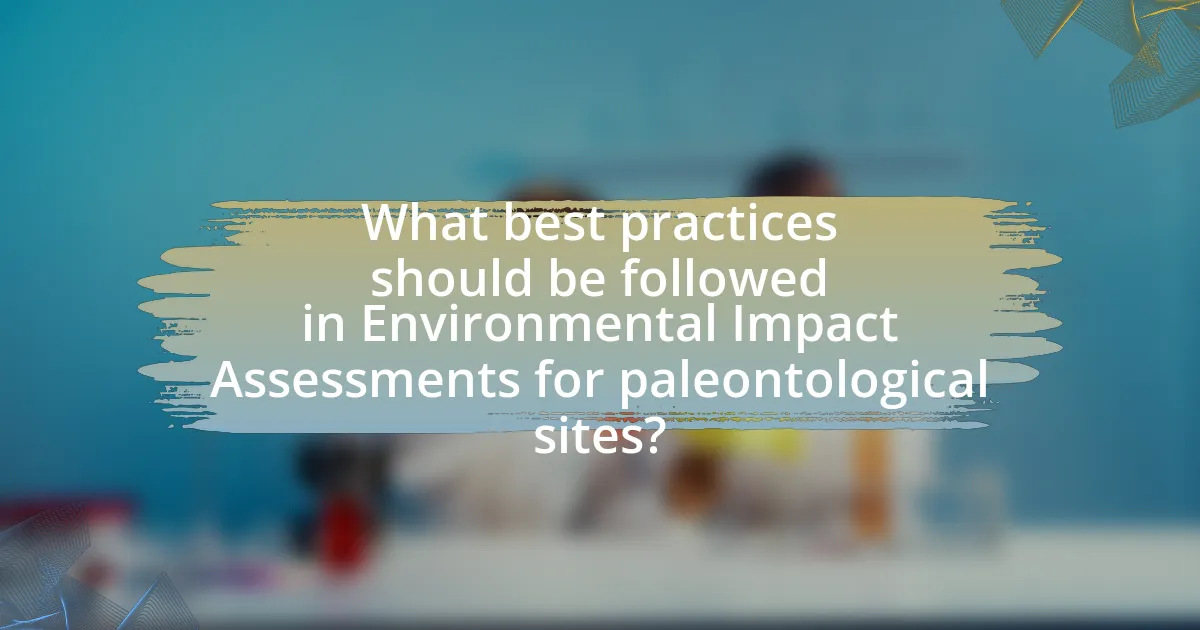
What best practices should be followed in Environmental Impact Assessments for paleontological sites?
Best practices in Environmental Impact Assessments (EIAs) for paleontological sites include conducting thorough baseline studies, engaging with paleontologists, and implementing mitigation strategies. Thorough baseline studies involve documenting existing paleontological resources and their significance, which helps in understanding potential impacts. Engaging with qualified paleontologists ensures that assessments are scientifically sound and that important fossil sites are identified. Implementing mitigation strategies, such as avoiding disturbance to significant fossil deposits or developing plans for excavation and curation, minimizes negative impacts on paleontological resources. These practices are supported by guidelines from organizations like the Society of Vertebrate Paleontology, which emphasizes the importance of preserving paleontological heritage during development projects.
How can practitioners ensure thorough and effective assessments?
Practitioners can ensure thorough and effective assessments by implementing a systematic approach that includes comprehensive data collection, stakeholder engagement, and adherence to established guidelines. Comprehensive data collection involves gathering geological, biological, and archaeological information relevant to the paleontological site, which can be supported by methodologies such as field surveys and remote sensing techniques. Stakeholder engagement is crucial, as involving local communities and experts can provide valuable insights and enhance the assessment’s credibility. Adhering to established guidelines, such as those set by the Society of Vertebrate Paleontology, ensures that assessments meet professional standards and regulatory requirements, thereby increasing their effectiveness.
What tools and technologies can enhance the assessment process?
Geographic Information Systems (GIS) and remote sensing technologies significantly enhance the assessment process for environmental impact assessments at paleontological sites. GIS allows for the spatial analysis of geological and ecological data, enabling researchers to visualize and interpret the relationships between paleontological resources and their environments. Remote sensing technologies, such as satellite imagery and aerial photography, provide comprehensive data on land use, vegetation cover, and geological features, which are crucial for identifying potential impacts on paleontological sites. Studies have shown that integrating these technologies can improve the accuracy of assessments and facilitate better decision-making regarding site management and conservation efforts.
How can continuous monitoring improve long-term outcomes for paleontological sites?
Continuous monitoring can significantly improve long-term outcomes for paleontological sites by enabling the early detection of environmental changes and potential threats. This proactive approach allows for timely interventions, such as implementing protective measures against erosion or human activities that could damage fossil deposits. For instance, studies have shown that sites with regular monitoring can better preserve their geological context, which is crucial for accurate scientific analysis and understanding of past ecosystems. Furthermore, continuous data collection facilitates adaptive management strategies, ensuring that conservation efforts are responsive to evolving conditions, thereby enhancing the overall integrity and longevity of paleontological resources.
What are the key takeaways for conducting successful Environmental Impact Assessments for paleontological sites?
Key takeaways for conducting successful Environmental Impact Assessments (EIAs) for paleontological sites include thorough baseline studies, stakeholder engagement, and adherence to regulatory frameworks. Thorough baseline studies involve detailed documentation of existing paleontological resources, which is essential for understanding the potential impacts of proposed projects. Stakeholder engagement ensures that the perspectives of local communities, scientists, and regulatory bodies are considered, fostering transparency and collaboration. Adherence to regulatory frameworks, such as the National Environmental Policy Act in the United States, provides a structured approach to evaluating impacts and implementing mitigation strategies. These practices are supported by case studies demonstrating that comprehensive EIAs lead to better conservation outcomes and informed decision-making in paleontological contexts.
